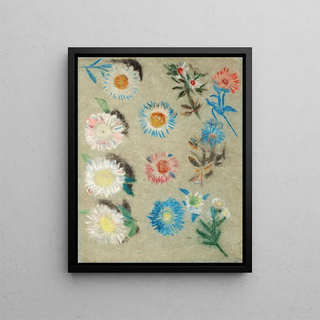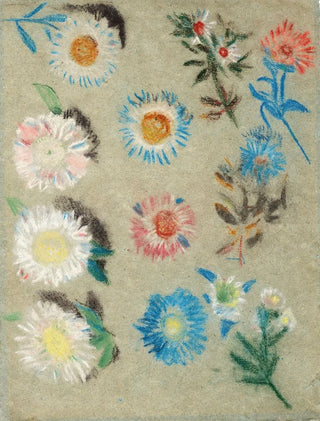Art print | Flower Study - Eugène Delacroix


View from behind

Frame (optional)
In the vibrant universe of art, some works transcend the simple frame of the canvas to become true hymns to beauty and nature. "Study of Flowers - Eugène Delacroix" fits into this tradition, revealing a unique sensitivity that awakens a deep admiration within us. This piece, both delicate and bold, invites us to dive into a world where each petal, each color, seems to vibrate with its own life. Contemplating this floral study, one feels an intimate connection with the very essence of nature, an invitation to rediscover the splendor of the shapes and nuances that surround us.
Style and uniqueness of the work
Eugène Delacroix's work is distinguished by its innovative approach and daring use of color. In "Study of Flowers," the composition is marked by subtle harmony, where the shades intertwine with remarkable fluidity. The flowers, although depicted realistically, exude an almost romantic aura, capturing the ephemeral beauty of nature. The choice of colors, ranging from pastel tones to more vivid hues, demonstrates the artist's technical mastery and keen aesthetic sense. Every detail is carefully studied, from delicate shadows to luminous reflections, creating a depth that invites wonder. This work is not only a botanical study but also a poetic exploration of life, where the sublime blends with simplicity.
The artist and his influence
Eugène Delacroix, an emblematic figure of French Romanticism, knew how to mark his era with an innovative artistic vision. Born in 1798, he established himself as one of the masters of painting thanks to his ability to capture human emotions and passions. His influence extends far beyond his time, inspiring many artists who followed in his footsteps. Delacroix managed to combine classical technique with a new expressiveness, paving the way for movements such as Impressionism and Symbolism. His fascination with nature and his talent for rendering its richness are particularly evident in "Study of Flowers." This work bears witness to his commitment to exploring beauty

Matte finish

View from behind

Frame (optional)
In the vibrant universe of art, some works transcend the simple frame of the canvas to become true hymns to beauty and nature. "Study of Flowers - Eugène Delacroix" fits into this tradition, revealing a unique sensitivity that awakens a deep admiration within us. This piece, both delicate and bold, invites us to dive into a world where each petal, each color, seems to vibrate with its own life. Contemplating this floral study, one feels an intimate connection with the very essence of nature, an invitation to rediscover the splendor of the shapes and nuances that surround us.
Style and uniqueness of the work
Eugène Delacroix's work is distinguished by its innovative approach and daring use of color. In "Study of Flowers," the composition is marked by subtle harmony, where the shades intertwine with remarkable fluidity. The flowers, although depicted realistically, exude an almost romantic aura, capturing the ephemeral beauty of nature. The choice of colors, ranging from pastel tones to more vivid hues, demonstrates the artist's technical mastery and keen aesthetic sense. Every detail is carefully studied, from delicate shadows to luminous reflections, creating a depth that invites wonder. This work is not only a botanical study but also a poetic exploration of life, where the sublime blends with simplicity.
The artist and his influence
Eugène Delacroix, an emblematic figure of French Romanticism, knew how to mark his era with an innovative artistic vision. Born in 1798, he established himself as one of the masters of painting thanks to his ability to capture human emotions and passions. His influence extends far beyond his time, inspiring many artists who followed in his footsteps. Delacroix managed to combine classical technique with a new expressiveness, paving the way for movements such as Impressionism and Symbolism. His fascination with nature and his talent for rendering its richness are particularly evident in "Study of Flowers." This work bears witness to his commitment to exploring beauty






